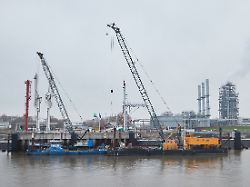Important “milestone” in Stade
Fifth LNG terminal reaches Germany
March 15, 2024, 11:47 a.m
Listen to article
This audio version was artificially generated. More info | Send feedback
Germany is taking a step forward in its energy independence. The fifth of six LNG terminals arrives at the port of Stade. A “milestone,” says District Administrator Seefried. In the future, five billion cubic meters of gas will be fed into the network there.
The fifth of six floating terminals for liquefied natural gas (LNG) nationwide has arrived in Stade. In the meantime, the almost 300 meter long “Energos Force” has anchored in the Stade energy port, the Stade district announced. District Administrator Kai Seefried spoke of an “important milestone in security of supply and stabilization of gas prices in Germany and Europe”. Accompanied by a large police presence, the ship reportedly entered the mouth of the Elbe shortly after midnight.
In addition to Stade, a second terminal in Wilhelmshaven is scheduled to go into operation in the coming months, as a spokesman for the federally owned operating company Deutsche Energy Terminal (DET) said. A floating LNG terminal has been in operation there for a year, as well as in Brunsbüttel in Schleswig-Holstein and in Lubmin in Mecklenburg-Western Pomerania. Another terminal is in trial operation in Mukran on the island of Rügen.
After several weeks of test operation, the terminal in Stade is expected to feed up to five billion cubic meters of gas per year into the German gas network, according to DET. To secure the energy supply in Germany and Europe, the third of four floating LNG terminals operated by the operator DET in Germany is currently being completed. With the arrival of the “Energos Force” an important step has been taken. The ship is 294 meters long and 47 meters wide.
The jetty for the floating terminal was handed over to the users Deutsche Energy Terminal and Hanseatic Energy Hub last December after almost eleven months of construction. According to the district, the pier in Stade is considered the largest water-side construction project in Germany’s ports. 300 million euros were invested in the facility.
According to earlier information from the state-owned port operator Niedersachsen Ports, around 50 LNG tankers will be handled at the new terminal on the Elbe each year. The construction of the new liquefied gas infrastructure was a response to Russia’s attack on Ukraine in February 2022. Liquefied gas imports are intended to help close the supply gap caused by the lack of Russian gas deliveries.
